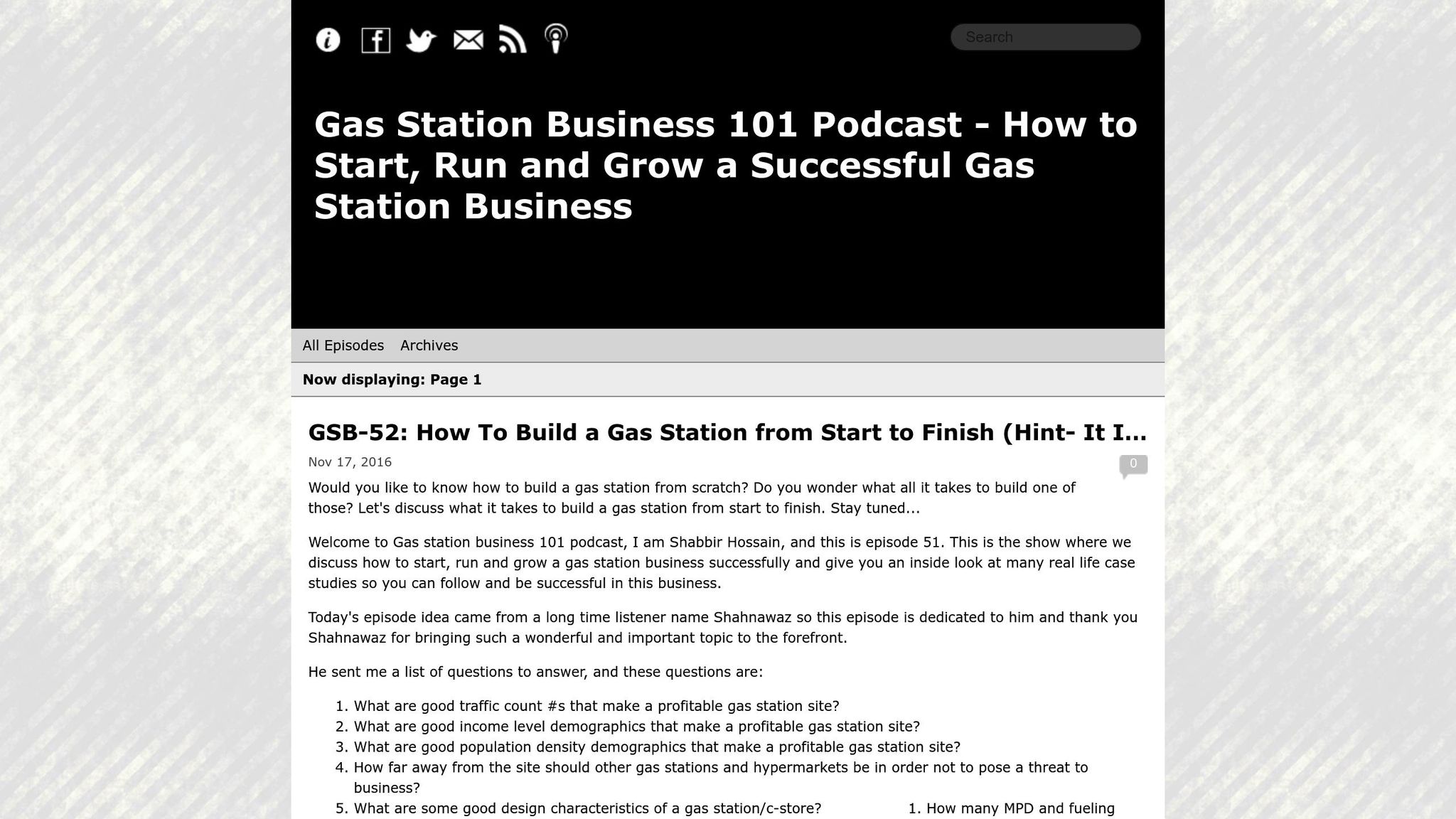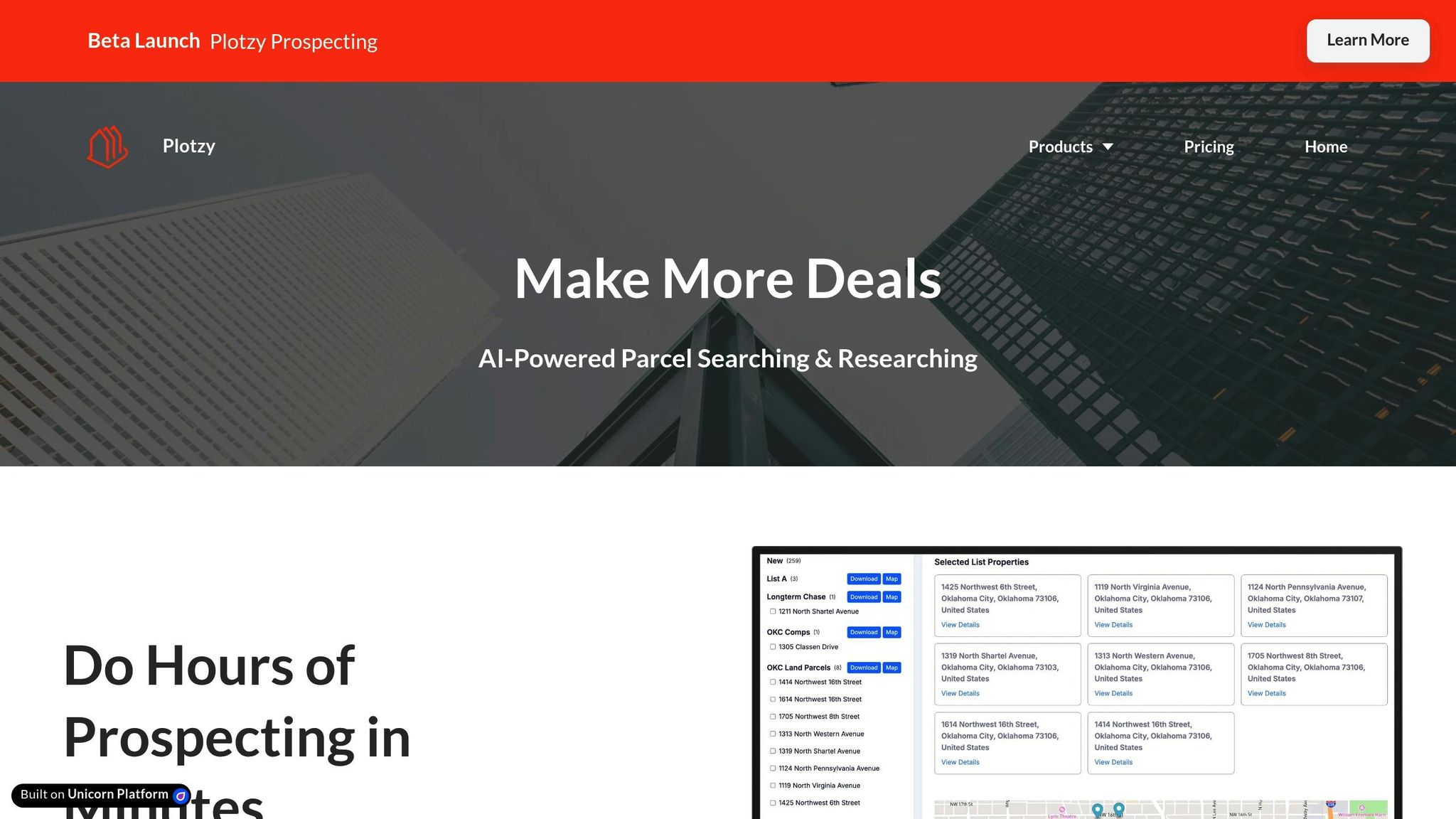- Zoning Basics: Gas stations are typically allowed in commercial or retail zones. You may need a Conditional Use Permit (CUP) if fuel sales aren't explicitly permitted.
- Key Requirements: Minimum lot size of 10,000 sq. ft., proper setbacks, parking, and compliance with fire safety and environmental codes are essential.
- AI Tools for Research: Platforms like Plotzy can simplify zoning research by pulling zoning data, generating reports, and identifying property owners.
- Steps to Get Permits: Review regulations, prepare spill prevention plans, engage the community, and consult experts to streamline approvals.
- Finding Sites: Focus on off-market parcels in high-traffic areas zoned for fuel sales, and use tools like Plotzy to assess zoning classifications and property details.
Plotzy helps you save time by automating zoning analysis, permit tracking, and property owner outreach - all in one platform.
GSB-52: How To Build a Gas Station from Start to Finish (Hint ...

Gas Station Zoning Rules
Before analyzing potential properties, it's important to understand the regulations that apply to gas station construction.
Allowed Uses and Zones
Check which commercial and retail zones allow gas stations, and look for any specific rules related to fuel sales or permits. These zones typically permit activities like fuel dispensing, convenience store operations, and basic automotive services.
Also, ensure the site meets the required dimensions and buffer standards.
Property Requirements
Zoning codes typically require a lot size of at least 10,000 square feet to accommodate fuel islands, setbacks, parking, and buffer zones. Use these criteria as filters in Plotzy to narrow down suitable properties.
Once a site is identified, compile the necessary permit documents based on these requirements.
Getting Zoning Permits
If fuel sales aren't explicitly permitted in the zoning rules, you may need to apply for a Conditional Use Permit. To increase your chances of approval, take these steps:
- Review zoning and environmental regulations thoroughly.
- Consult with land-use attorneys.
- Prepare detailed studies on fuel storage and spill prevention.
- Engage with the local community early in the process.
Plotzy can help you monitor the status of your permits and keep all application details organized alongside property data.
Using Plotzy for Zoning Analysis

Plotzy simplifies zoning analysis into three key steps: finding parcels, generating reports, and identifying property owners.
Finding Zoned Parcels
Plotzy's AI-powered parcel search helps you locate sites suitable for gas stations. It filters commercial zones that allow fuel sales, considers lot size and street frontage, and overlays municipal zoning maps with property data. This approach eliminates hours of manual research and gets you straight to the most relevant options.
Creating Zoning Reports
Once you've identified potential sites, you can create detailed reports for each one. These reports include zoning classifications, allowed uses, development standards (like setbacks, height limits, and lot coverage), and specific fuel sales requirements. All data comes directly from municipal sources, ensuring it's up-to-date and reliable.
Finding Property Owners
After narrowing down your options, Plotzy provides owner names and contact details for direct outreach. With the Pro plan, you can perform unlimited owner searches, making it easy to build a strong pipeline of prospects efficiently.
sbb-itb-11d231f
Finding Gas Station Sites
After using Plotzy to generate zoning reports and identify property owners, you can narrow your search by focusing on off-market parcels and conducting thorough evaluations.
Off-Market Properties
Look for off-market parcels that are already zoned for fuel sales, are large enough to accommodate fueling infrastructure, and are positioned on busy roads or at major intersections. These types of locations often have strong potential for development.
Site Assessment
When assessing a potential site, consider:
- Zoning classifications or conditional use permit (CUP) requirements
- Lot size and shape
- Traffic volume and ease of entry/exit
- Compliance with hazardous materials storage regulations
Researching City Records
Dive into municipal records to uncover site-specific rules and restrictions. Key documents to review include:
- Zoning maps, overlay districts, setbacks, and parking standards
- CUP processes and any special conditions that might apply
Plotzy simplifies this process by offering tools to access zoning maps, classifications, and permit requirements in one place. This helps you spot any potential issues early in your search.
Solving Site Selection Problems
Plotzy's zoning overlays can help you identify sites that might need rezoning or variances before involving stakeholders.
Rezoning and Variances
Once you’ve pinpointed potential parcels, Plotzy can reveal if the site requires zoning adjustments. For example, if the property isn’t zoned for gas station use, you’ll need to explore options like rezoning or applying for a Conditional Use Permit (CUP). A CUP allows for specific uses not typically permitted, as long as certain conditions are met.
To navigate this process, work with legal and environmental experts to:
- Investigate the site's zoning classification and local regulations.
- Simplify your CUP application process with guidance from attorneys and environmental consultants.
Approvals & Compliance
Getting approvals and staying compliant involves early and effective communication with the community, as well as meeting regulatory standards. Developers often focus on these two key areas:
Community Engagement
- Organize meetings to inform residents and address their concerns.
- Incorporate feedback into your project design to ease potential objections.
- Use Plotzy to track deadlines and community input effectively.
Regulatory Requirements
- Prepare detailed safety and operational plans.
- Store critical documents like impact studies, spill prevention plans, and fire marshal approvals in Plotzy’s document library.
- Keep an eye on application progress and deadlines using Plotzy’s dashboard.
Once variances are approved and all documentation is in order, you’ll be ready to move forward with final site preparations.
Summary
This guide covered zoning requirements, Plotzy's AI tools, and actionable steps to secure a compliant gas station site.
Key Zoning Rules
Gas stations located in commercial or retail zones must adhere to fire safety and environmental standards. Additionally, obtaining business, fuel, and environmental permits is mandatory.
Plotzy's Main Features
Plotzy's AI tools simplify the process by allowing users to filter parcels that meet zoning requirements, create instant reports, find property owner contacts, and analyze parcel data - all within a single platform.
Next Steps
- Verify zoning and screen potential sites using Plotzy's platform.
- Bring in legal and environmental experts to handle required permits.
- Develop a community outreach plan to engage local stakeholders effectively.


